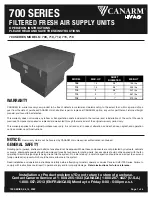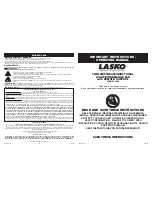
In the event of any problems or queries, consult your agent or contact the
manufacturer directly.
2. CONSTRUCTION AND REGULATORY
This product was designed to be used with products suitably studied for the
specific application. If assembled incorrectly, use of the product with other
devices may result in damage or malfunctions.
The power supply system and electrical
standards for electrical systems.
The equipment has double electrical insulation and thus does not require
an earth wire. All devices connected to the station must be earthed by the
installer unless equipped with double insul
All the devices connected to the control units must be manufactured according
to current regulations.
3. TECHNICAL DATA
Model
Power supply voltage of the station
Maximum current absorbed from the
electrical grid
Output voltage
Maximum switchable output current
Service type
Setup for connection to external devices
Electrical insulation class
Operating temperature
Degree of protection of the electrical devices
The data provided in these illustrations is non
4. ID PLATE AND MARKING DATA
KH1 and KH1R have
marking and are destined for use in the European Union without
further requirements.
ID plate data are indicated on a polyethylene adhesive label applied externally on the
outside of the container, printed in black on a grey background. Values conform
requirements in force.
5. RECOMMENDATIONS AND INSTRUCTIONS FOR ASSEMBLY
T
HESE INSTRUCTIONS ARE INTENDED FOR TECHN
T
HUS BASIC SAFETY AND
In order to guarantee perfect operation of the
instructions and warnings below.
Page 5
In the event of any problems or queries, consult your agent or contact the
manufacturer directly.
CONSTRUCTION AND REGULATORY REFERENCES
This product was designed to be used with products suitably studied for the
specific application. If assembled incorrectly, use of the product with other
devices may result in damage or malfunctions.
The power supply system and electrical connection must comply with EU
standards for electrical systems.
The equipment has double electrical insulation and thus does not require
an earth wire. All devices connected to the station must be earthed by the
installer unless equipped with double insulation.
All the devices connected to the control units must be manufactured according
to current regulations.
KH1
Power supply voltage of the station
230 V~ 50 Hz
Maximum current absorbed from the
2.5A
230 V~
Maximum switchable output current
Max 1x
Continuous
Setup for connection to external devices
Wind - Rain
Temperature Sensor
command
-5°C -
Degree of protection of the electrical devices
IP
The data provided in these illustrations is non-binding and subject to change, even without advance notice.
ID PLATE AND MARKING DATA
marking and are destined for use in the European Union without
ID plate data are indicated on a polyethylene adhesive label applied externally on the
outside of the container, printed in black on a grey background. Values conform
RECOMMENDATIONS AND INSTRUCTIONS FOR ASSEMBLY
E INTENDED FOR TECHNICAL AND SPECIALIZED
HUS BASIC SAFETY AND WORKING TECHNIQUES ARE NOT DISCUSSED
In order to guarantee perfect operation of the system and facilitate installation, follow the
instructions and warnings below.
In the event of any problems or queries, consult your agent or contact the
This product was designed to be used with products suitably studied for the
specific application. If assembled incorrectly, use of the product with other
connection must comply with EU
The equipment has double electrical insulation and thus does not require
an earth wire. All devices connected to the station must be earthed by the
All the devices connected to the control units must be manufactured according
KH1R
230 V~ 50 Hz
2.5A
230 V~ 50 Hz
Max 1x 2.5A
Continuous
Rain - Brightness –
Temperature Sensor – open/close
command
II
- +65ºC
IP65
binding and subject to change, even without advance notice.
marking and are destined for use in the European Union without
ID plate data are indicated on a polyethylene adhesive label applied externally on the
outside of the container, printed in black on a grey background. Values conform to EC
RECOMMENDATIONS AND INSTRUCTIONS FOR ASSEMBLY
ICAL AND SPECIALIZED PERSONNEL
.
RE NOT DISCUSSED
.
system and facilitate installation, follow the
Perform a thorough visual inspection of the device to ensure it wasn't damaged
during transport.
To avoid the hazard of injury or death caused by the electrical current,
disconnect the voltage from the power supply line before carrying out any wiring
or adjustment operation.
The electrical power supply system must be designed and implemented in
compliance with current standards.
Caution.
Check that the elect
specified on the “technical data” label attached to the station.
When assembling the KH1 and KH1R stations, in order to guarantee perfect operation of
the system and facilitate installation, follow the
The rain and wind detectors are placed outside in direct contact with the weather, on the
roof or in a similar position if possible.
Some advises:
a) The rain sensor should be placed in a slightly inclined position in order to
water run-off and in a position which is not protected from falling rain; positioning the
sensor underneath trees is not recommended as this will alter the natural
meteorological event.
b) The wind sensor should be placed far from obstacles that d
wind flow; thus avoid placing the sensor near gutters, trees, walls, etc.
c) Select the most suitable location for the control unit based on the shape and structure
of the building. The station does not require any maintenance, th
an out-of-the-way position, protected against direct weather exposure.
d) Position the box of the device in the selected position and use a pencil to mark the
drilling hole on the support (wall or other).
e) Drill the hole using a drill b
fastening screw.
f) Mount the equipment box and fix the screws definitively.
g) Drill the box to allow passage of the connection cables in the desired position using a
Ø10 drill bit. Remove the electronic bo
permanently when drilling.
h) Complete the path of the electrical connection cables. Make the electrical connections
according to the wiring diagram provided on the following pages.
i) Perform the final test checking the int
commands (see paragraph 6.2)
6. TECHNICAL OPERATING INFORMATION
6.1.
General instructions
The station can control one
switchable current specified in the “Technical Data” table.
motor, the installation of a manual button
“deadman's switch”, is recommended.
The
KH1R
model provides for use of both the
433.92 MHz proprietary protocol, and manual control.
Page 6
Perform a thorough visual inspection of the device to ensure it wasn't damaged
To avoid the hazard of injury or death caused by the electrical current,
disconnect the voltage from the power supply line before carrying out any wiring
or adjustment operation.
The electrical power supply system must be designed and implemented in
compliance with current standards.
Check that the electric power supply used corresponds to that
specified on the “technical data” label attached to the station.
When assembling the KH1 and KH1R stations, in order to guarantee perfect operation of
the system and facilitate installation, follow the instructions and warnings below.
The rain and wind detectors are placed outside in direct contact with the weather, on the
roof or in a similar position if possible.
The rain sensor should be placed in a slightly inclined position in order to
off and in a position which is not protected from falling rain; positioning the
sensor underneath trees is not recommended as this will alter the natural
The wind sensor should be placed far from obstacles that deform or protect against the
wind flow; thus avoid placing the sensor near gutters, trees, walls, etc.
Select the most suitable location for the control unit based on the shape and structure
of the building. The station does not require any maintenance, th
way position, protected against direct weather exposure.
Position the box of the device in the selected position and use a pencil to mark the
drilling hole on the support (wall or other).
Drill the hole using a drill bit with diameter corresponding to the selected plug or
Mount the equipment box and fix the screws definitively.
Drill the box to allow passage of the connection cables in the desired position using a
Ø10 drill bit. Remove the electronic board from the box to avoid damaging it
Complete the path of the electrical connection cables. Make the electrical connections
according to the wiring diagram provided on the following pages.
Perform the final test checking the intervention of the automatic devices.
commands (see paragraph 6.2).
TECHNICAL OPERATING INFORMATION
General instructions
The station can control one actuator at 230V~ 50 Hz; pay attention to the maximum
switchable current specified in the “Technical Data” table. For control of the connected
motor, the installation of a manual button voltage-free
n.o.
type
“deadman's switch”, is recommended.
model provides for use of both the
PIK
model radio remote control, with
433.92 MHz proprietary protocol, and manual control.
Perform a thorough visual inspection of the device to ensure it wasn't damaged
To avoid the hazard of injury or death caused by the electrical current, always
disconnect the voltage from the power supply line before carrying out any wiring
The electrical power supply system must be designed and implemented in
ric power supply used corresponds to that
specified on the “technical data” label attached to the station.
When assembling the KH1 and KH1R stations, in order to guarantee perfect operation of
instructions and warnings below.
The rain and wind detectors are placed outside in direct contact with the weather, on the
The rain sensor should be placed in a slightly inclined position in order to facilitate
off and in a position which is not protected from falling rain; positioning the
sensor underneath trees is not recommended as this will alter the natural
eform or protect against the
wind flow; thus avoid placing the sensor near gutters, trees, walls, etc.
Select the most suitable location for the control unit based on the shape and structure
of the building. The station does not require any maintenance, thus it can be placed in
way position, protected against direct weather exposure.
Position the box of the device in the selected position and use a pencil to mark the
it with diameter corresponding to the selected plug or
Drill the box to allow passage of the connection cables in the desired position using a
ard from the box to avoid damaging it
Complete the path of the electrical connection cables. Make the electrical connections
according to the wiring diagram provided on the following pages.
ervention of the automatic devices. And of all
pay attention to the maximum
For control of the connected
type, also known as a
model radio remote control, with


























